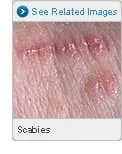What Are Lice?
Lice are tiny parasites that live on human beings and feed on blood. They seldom cause serious medical problems, but they are both annoying and contagious. There are three types of lice that can live on people.
Head lice (Pediculus humanus capitis) are about the size of a sesame seed or 2.1 to 3.3 millimeters long when adults. Their eggs, called nits, are barely visible whitish or yellow ovals that attach to hair shafts. Having head lice isn’t related to the degree of personal hygiene. Head lice are contagious, especially among schoolchildren. They afflict an estimated 6 million to 12 million children in the United States each year. More girls get head lice — likely because girls have more physical contact with one another and share more personal articles (such as hats, clothing, combs) that can transmit head lice. Head lice are rare among African-Americans, possibly because the shafts of their hair have a shape that lice cannot grasp easily.
Pubic lice (Pthirus pubis) are yellow-gray parasites found in the pubic region and transmitted by sexual contact. They are only 1.1 to 1.8 mm long and are also called crab lice, or crabs, because of their shape and the crab-like claw-like front legs with which they cling to hair. Eggs can barely be seen; these tiny white particles attach so firmly to hair shafts that they are not removed by normal washing. Sometimes pubic lice may be found in other areas of the body containing coarse hair, such as armpits or the chest.
Body lice (Pediculus humanus corporis) are nearly identical in appearance to head lice but may be more difficult to find. Adults grow to 2.3 to 3.6 mm long. When not feeding, they tend to hide in the seams of clothing and folds of bedding. If the lice are not treated, the person can develop complications such as skin sores or bacterial infection of the affected area. Body lice can also spread blood infections.
Lice are found all over the world, wherever people gather in close proximity, such as in schools.
What Is Scabies?

Scabies is another contagious skin disease caused by the mite Sarcoptes scabiei var. hominis. The primary symptom — an incredibly itchy rash — results when the female mite burrows into the skin and deposits eggs. Female mites grow to 0.3 to 0.45 mm long and are larger than males. Closed environments such as nursing homes and child-care centers provide ideal breeding grounds for this parasite, which needs a human host to survive.
Additional Resources
- ACNE Causes – CIELLULU Laser Beauty
- Ciellulu Laser – CIELLULU Laser Beauty
- Carbon Laser Tattoo Removal Reviews: Patient Experiences – CIELLULU Laser Beauty
- How to Maximize Treatment Efficiency with the Ciellulu S500 Diode Laser – CIELLULU Laser Beauty
- Laser Skin Rejuvenation Elgin: Providers and Treatments – CIELLULU Laser Beauty